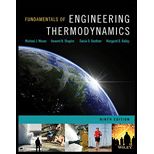
Fundamentals Of Engineering Thermodynamics, 9e
9th Edition
ISBN: 9781119391432
Author: MORAN
Publisher: WILEY
expand_more
expand_more
format_list_bulleted
Question
error_outline
This textbook solution is under construction.
Students have asked these similar questions
Consider the combined gas-steam power cycle. The topping cycle is a gas-turbine cycle that has a pressure
ratio of 8. Air enters the compressor at 300 K and the turbine at 1300 K. The isentropic efficiency of the
compressor is 80%, and that of the gas turbine is 85%. The bottoming cycle is a simple Rankine cycle
operating between the pressure limits of 7 MPa and 5 kPa. Steam is heated in a heat exchanger by the
exhaust gases to a temperature of 500°C and the isentropic efficiency of the turbine is 90 %. The exhaust
gases leave the heat exchanger at 450 K. Considering the mass flow rate steam as 1 kg/s, determine:
A) Net power, B) Total input heat, C) Total entropy generation, D) Energy efficiency, E) Exergy efficiency,
F) T-s diagram
Solve by EES
Compressor
Air -③
in
Exhaust
gases
Pump
Combustion
chamber
Gas
turbine
Gas cycle
Heat exchanger
Condenser
Steam
Steam
turbine
cycle
I need expert solution s to this question, don't use Artificial intelligence
I need solutions to this questions
Don't use Artificial intelligence
Knowledge Booster
Similar questions
- Please consider the following closed-loop Multiple-Input Multiple-Output (MIMO) control system: R₁(s) and R2(s) are the reference signals (or inputs), • G₁(s) (where i = 1,2,3,4,5) are the plant transfer functions, • C₁(s) and C2(s) are the responses (or system outputs), • All of them are in Laplace domain. R2 + R₁ + + G₂(s) G3(S) Tasks: G5(s) G4(s) + G₁(s) می a) Please derive the transfer function between C₁ (s) and R₂(s) (i.e., find R₂(s) (10 marks) (10 marks) b) Please derive the transfer function between C₂(s) and R₁(s) (i.e., find C2 (s)). R₁(s) Hint: Please carefully analyse how the signals interact with the plants G₁(s) and find all paths fromarrow_forwardMột thanh dài L = 2,5 m được nối bằng chốt với một con lăn ở A. Con lăn chuyển động dọc theo một đường ray nằm ngang như hình vẽ với VA 5 m/s. Xác định vận tốc của điểm C (trung điểm của thanh AB) = tại thời điểm 0 = 33° và O = 0.4 rad/s. A. v = (-5.42+0.272})(m/s) C. v = (5.421+0.272})(m/s) B. v =(0.272i+5.42j)(ms) D. (5.42-0.272)(m/s) = C Barrow_forwardThe simulink and Matlab part are the prioritized areas please.arrow_forward
- Please do not rely too much on chatgpt, because its answer may be wrong. Please consider it carefully and give your own answer. You can borrow ideas from gpt, but please do not believe its answer.Very very grateful! Please do not copy other's work,i will be very very grateful!!arrow_forwardAn industrial burner uses natural gas as fuel. The natural gas consists primarily of CH4 with small quantities of several other light hydrocarbons and can be represented as C1.16H4.32 To achieve low emissions of oxides of nitrogen, the burner operates lean at equivalence ratio of 0.4. Assume complete combustion and answer the following questions. i) What is the operating air-fuel ratio (i.e. mass air/mass of fuel)? [6 marks] ii) What is the percent excess air in the combustion products? [3 marks] iii) What is the oxygen (O2) mole fraction in the combustion products? [6 marks]arrow_forward1) Consider the robot, with six degrees of freedom, RRPRR, shown in the following figure.Place the axes through the denavit-hartenberg algorithm and obtain the respective parameter table for the first three joints. 2) Considering the robot from question 1, calculate.the. Determine the Homogeneous Transformation Matrix in relation to the Direct Kinematics of the robot, for the first three joints:b. Considering the first three joints of the robot and L1 and L2 equal to 200 mm:I. calculate the pose of the robot relative to the base, knowing the joint variableshave the following values: q1= 90°, q2= 0°, q3= 50mm:arrow_forward
- Please do not rely too much on chatgpt, because its answer may be wrong. Please consider it carefully and give your own answer. You can borrow ideas from gpt, but please do not believe its answer.Very very grateful! Please do not copy other's work,i will be very very grateful!!arrow_forwardDon't use Artificial intelligencearrow_forwardSolve this problem and show all of the workarrow_forward
arrow_back_ios
SEE MORE QUESTIONS
arrow_forward_ios
Recommended textbooks for you
 Elements Of ElectromagneticsMechanical EngineeringISBN:9780190698614Author:Sadiku, Matthew N. O.Publisher:Oxford University Press
Elements Of ElectromagneticsMechanical EngineeringISBN:9780190698614Author:Sadiku, Matthew N. O.Publisher:Oxford University Press Mechanics of Materials (10th Edition)Mechanical EngineeringISBN:9780134319650Author:Russell C. HibbelerPublisher:PEARSON
Mechanics of Materials (10th Edition)Mechanical EngineeringISBN:9780134319650Author:Russell C. HibbelerPublisher:PEARSON Thermodynamics: An Engineering ApproachMechanical EngineeringISBN:9781259822674Author:Yunus A. Cengel Dr., Michael A. BolesPublisher:McGraw-Hill Education
Thermodynamics: An Engineering ApproachMechanical EngineeringISBN:9781259822674Author:Yunus A. Cengel Dr., Michael A. BolesPublisher:McGraw-Hill Education Control Systems EngineeringMechanical EngineeringISBN:9781118170519Author:Norman S. NisePublisher:WILEY
Control Systems EngineeringMechanical EngineeringISBN:9781118170519Author:Norman S. NisePublisher:WILEY Mechanics of Materials (MindTap Course List)Mechanical EngineeringISBN:9781337093347Author:Barry J. Goodno, James M. GerePublisher:Cengage Learning
Mechanics of Materials (MindTap Course List)Mechanical EngineeringISBN:9781337093347Author:Barry J. Goodno, James M. GerePublisher:Cengage Learning Engineering Mechanics: StaticsMechanical EngineeringISBN:9781118807330Author:James L. Meriam, L. G. Kraige, J. N. BoltonPublisher:WILEY
Engineering Mechanics: StaticsMechanical EngineeringISBN:9781118807330Author:James L. Meriam, L. G. Kraige, J. N. BoltonPublisher:WILEY

Elements Of Electromagnetics
Mechanical Engineering
ISBN:9780190698614
Author:Sadiku, Matthew N. O.
Publisher:Oxford University Press

Mechanics of Materials (10th Edition)
Mechanical Engineering
ISBN:9780134319650
Author:Russell C. Hibbeler
Publisher:PEARSON

Thermodynamics: An Engineering Approach
Mechanical Engineering
ISBN:9781259822674
Author:Yunus A. Cengel Dr., Michael A. Boles
Publisher:McGraw-Hill Education

Control Systems Engineering
Mechanical Engineering
ISBN:9781118170519
Author:Norman S. Nise
Publisher:WILEY

Mechanics of Materials (MindTap Course List)
Mechanical Engineering
ISBN:9781337093347
Author:Barry J. Goodno, James M. Gere
Publisher:Cengage Learning

Engineering Mechanics: Statics
Mechanical Engineering
ISBN:9781118807330
Author:James L. Meriam, L. G. Kraige, J. N. Bolton
Publisher:WILEY